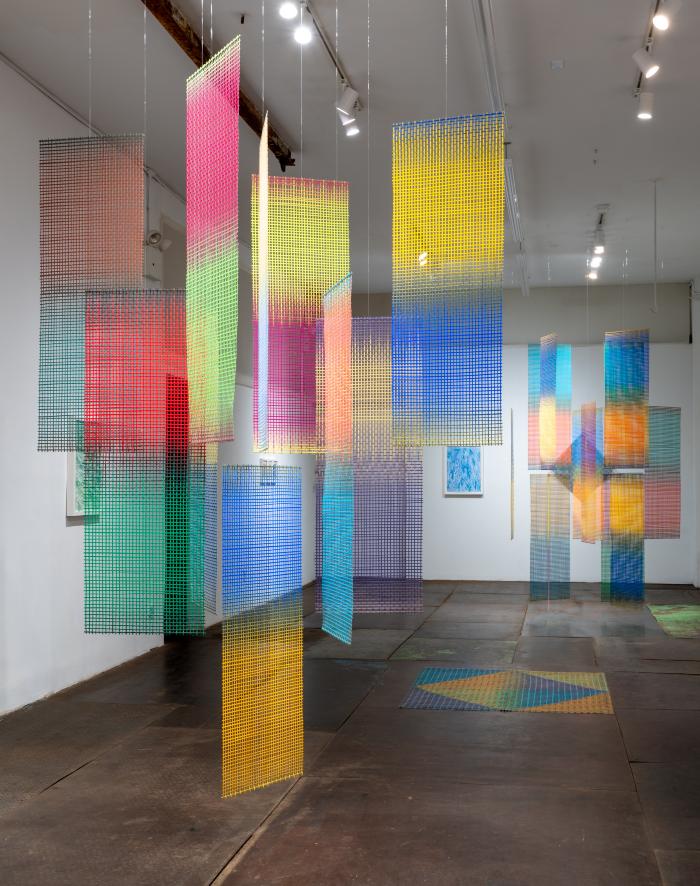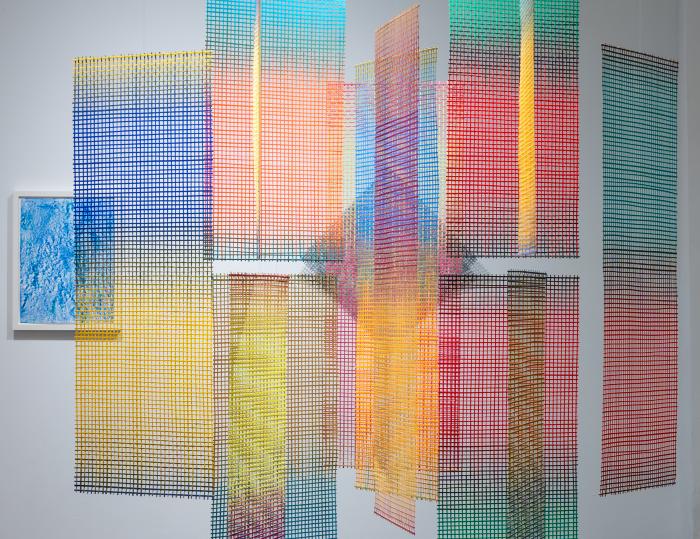exhibition
Joell Baxter, Observer Effect
Date
November 9 – December 15, 2024Opening Reception
November 9, 2024Essay By
Imani FordArtist
Joell BaxterRelated exhibition
Focus on the Flatfiles: Color MovesRelated event
Artist's Talk with Joell Baxterexhibition Images
About the exhibition
Joell Baxter
OBSERVER EFFECT
November 9 - December 15, 2024
Opening Reception: Saturday, November 9, 4-6pm
Artist’s Talk: Saturday, November 23, 4pm
Optical Allusions: Envisioning Alongside Joell Baxter’s Observer Effect
Over, under, over, under, and over again. This playful, obsessive, repetitive process describes the visual rhythm of Joell Baxter’s work – polychrome weavings and drawings (and, in this exhibition, monochrome floor rubbings) that hang from the ceiling and off the wall. Inspired by Friedrich Froebel’s Inventing Kindergarten – a system for teaching small children about math, art, and design – Baxter’s systems consist of a set of rules that manifest each piece. Some pieces share the same rules, and some differ. These systems dictate how, what, when, and where Baxter weaves, layers, and glues strips of 140-lb watercolor paper that are doused in heavy pigment. Each piece suggests a symbiotic relationship between space and object. In Baxter’s words, “They are pushing against the space. And the space is pushing against them.”
Collider I and Collider II hang diagonally at each end of the gallery. Each piece is long, rectangular, woven, and composed of multiple panels. They hang freely and subtly turn throughout the space. Like Baxter’s other pieces, Collider I and Collider II are composed of colors that are at once complementary and contradictory. According to Baxter, the titles reference particle colliders, in which “atoms speed up, smash together, and reveal their inner structure.”
For Baxter, Collider I and II’s reference to physical reactions reflects the colorful, formal, and interactive aspects of each piece. Collider I and II force viewers to move around them. According to Baxter, they also “frame a contrast between the external experience of the piece, which moves slowly and hypnotically in the space, and the frenetic interior pace of the viewer’s perceptual neurons firing.”
By employing various systems and colors that refuse the brain’s desire for “clarity” or “coherence” (i.e., representational imaging), Baxter also upends our assumptions that sight is synonymous with knowing. She disrupts Eurocentric conceptions of knowing, meaning-making, and reality. Observer Effect accepts the old maxim “I have to see it to believe it,” yet slowly elides it. Here, to look is not seeing; to see is not knowing.
Collider I and Collider II force the observer to see the off-the-wall work through various perspectives – perspectives dictated by Baxter’s systems and strategic installation decisions. Through the spaces of Collider I and Collider II the eye must take the body’s place in approaching pieces on the wall from certain angles and perspectives. Though semi-translucent, Collider I and Collider II suggest that Baxter’s work uses the eye to supersede the body, and awaken within the observer a site that shifts spatially, temporally, and cognitively between the self that sees, the self that knows what it’s like to inhabit space, and the self that imagines a new way of seeing and therefore inhabiting space as an embodied being whose consciousness comes first. Shifting color spectrums, layers of watercolor, severed and colored layers of weaves turned in different directions, and dizzying, yet dopamine-inducing patterns give the mind space while disrupting its normative processes.
This experiential tension that Baxter’s intricately woven systems use shifts color spectrums to make the observer see themselves, both large and small, macroscopic and microscopic, among her objects. The observer not only observes themselves but realizes, through observation, that they, too, are mere objects in a room, in a building, in a city, in a system. Baxter subtly demands self-interrogation and interrogation that requires an inner eye rather than the ocular eye. This inner eye transforms the viewer into a self (an inner “I”) that can no longer contend with its singularity and individuality but must ask how they are one of the transitional pigments or plaits of watercolor paper that make up one of the weaves that hang on the wall. While our eyes might want very badly to demand of Baxter’s work a clear image, or answer, to the inner musings her work precipitates, these objects push us running back to ourselves and perhaps one another. We can demand more by moving around the space and listening to where (and how) the work tells us to look. We might notice that we can only see some works on the wall from vantage points through the pieces that hang. We may also notice that we might be prohibited from some looks or ways of seeing. In this sense, the work demands that we look through it and ourselves across space, amid packed layers, and weavings that allow for more transparency. We are, however, always at the mercy of Baxter’s almost systematic objectivity that, in its objectivity, forces us to contend with our subjectivity and the artist’s obsession, care, and preoccupation with endless expansion under constant constraint.
Perhaps this is where we find an answer to the capacity of abstraction both under ocular duress and free from it. The observer’s eye, like the object to the wall, seems to press upon the surface of the weave, hoping to find some release from the intensity of color, intensity of response to it, and erotic desire for more of what the eye can neither contain, decipher, or make sense of up close. It is, however, across several mediums – rubbings, drawings, weavings – and from multiple levels of nearness and farness that the observer begins to understand what they might be looking at.
Like her predecessors – Agnes Martin, Sol Lewitt, Sam Gilliam, Katharina Grosse, and MacArthur Binion – Baxter expands our experiences of velocity, space, color, and medium. Her objects, however, allude to a new field of aesthetic, affective, haptic, and psychological interrogation. Observer Effect elicits a series of questions:
What does it mean to know what you are looking at? What does it mean to look beyond the assumption that it is the first step to seeing? What are the political potentialities of an abstraction that employs systems to systemically reorder our experiences, perceptions, and grasp on ourselves in the present moment? (And our assumptions about what the present moment and reality mean, and our purpose in shaping the structures that create them.)
By demanding self-interrogation, Baxter demands something of the medium, our perception of the medium, and the political present. Process and change are the impulses toward an abstract future that we choose one look, movement, choice, and weave at a time.
- Imani Ford (they/he) is an artist, writer, art-critic, and teaching artist from Chicago, now based in New York City.







